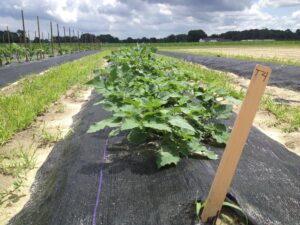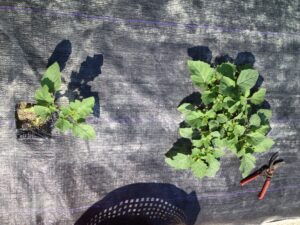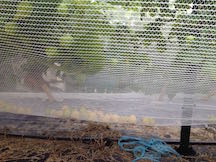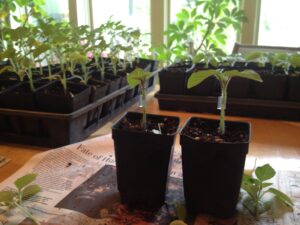2016 Annual Report for FNE16-843
Methods for improving quality and conditions of ground cherry production-part II
Summary
This project was a continuation of experiments to improve the efficiency of ground cherry harvest, for the purpose of reducing labor and increasing their viability as a fresh market and value-added crop. Previous experiments established that pruning and trellising, in combination with a net trough to catch the fruit (PTN), improved the quality of the fruit, reduced labor and amount of time taken for harvest, however, yields suffered due to delayed fruiting. In order to address this delay, we trialed three earlier start times for nursery transplants, with the pruning process beginning prior to field transplant. Additionally, Ground cherry scions were grafted to Tomatillo rootstock in the hopes of creating a more upright architecture for the plants, thus negating the need for PTN. Grafting has also been known to hasten maturity in some plants.
Time, yield, and quality data was collected twice a week during the harvest season. Outreach was conducted at a Twilight Tour of the Lower Eastern Shore Research and Education Center, in Salisbury, Maryland.
Objectives/Performance Targets
Four sowings of Cossack pineapple Ground cherries were planted on the following dates, using 128 trays on a heated germination mat: Feb. 19 (T1), March 3(T2), March 18 (T3), and April 1(T4), 2016. The final sowing, T4, represents the standard, recommended start time of six-weeks prior to field transplant, and was used as the control. All nursery stock was upsized in to larger pots as needed, early flowers were pinched off, and the earliest plantings, T1 and T2, had some early pruning. Some transplants were lost to freezing, when we experienced a power failure in the nursery.
On May 27, treatments 1-4 were transplanted to 3’x100’ raised beds, on black ground
cover with drip irrigation, at the Lower Eastern Shore Research and 
Education Center. Plant spacing was 2’ apart, in row. This date was two weeks later than planned, due to cold temperatures and wet conditions that deterred bed preparation. The aforementioned loss of transplants due to freezing resulted n fewer than the intended 50 plants per treatment. The final number of plants were as follows: T1-32, T2-33, T3-44,
T4-44. Treatment beds 1-3 had stakes driven every ive feet, to support  two plants between every set, and plants were pruned, as needed, to create a more upright habit that allowed plants to be supported, using tomato clips to attach branches to twine. Crosspieces were attached to every other stake, creating a “T” shape, and a rough was created by cutting a 7’x100’ piece of insect netting lengthwise, and attaching it underneath the plant canopy, and tothe crosspieces. The netting was used to catch the fruit, eliminating contact
two plants between every set, and plants were pruned, as needed, to create a more upright habit that allowed plants to be supported, using tomato clips to attach branches to twine. Crosspieces were attached to every other stake, creating a “T” shape, and a rough was created by cutting a 7’x100’ piece of insect netting lengthwise, and attaching it underneath the plant canopy, and tothe crosspieces. The netting was used to catch the fruit, eliminating contact with the ground, and making the fruit easier to harvest.
with the ground, and making the fruit easier to harvest.
For the grafting portion of the project, Verde Puebla Tomatillo, intended for rootstock, were sown on March 3, with the Ground cherries intended for use as scions sown on March 11. In previous experiments it was
determined that a week between sowings would provide more uniform stem diameters, which would make grafting easier, and more successful.
On May 6, 31 Ground cherry scions were grafted toTomatillo rootstock. All plants were placed in a grafting chamber, constructed from pvc pipe, a refrigerator drain pan, and wrapped in plastic. The chamber was kept in an approx. 85 degree, 90% humidity environment.

The process used followed recommendations for grafting tomato plants. While early results were good, only five of the grafted plants survived to the field transplant stage. These were planted in the same manner as T1-T3.


Accomplishments/Milestones
Observations:
Ground cherry plants, started in nursery trays/flats, are in a hurry to flower, and it is difficult to keep them in the vegetative stage, although, once planted to the field, they will resume vigorous vegetative growth.
Early pruning, in the nursery transplant stage, resulted in more branching and plants still needed significant pruning once transplanted to the field. Plants started earlier in the nursery did start producing fruit earlier than the previous year’s trial, when all transplants (pruned and un-pruned) were started at the same time.
Five, out of thirty-one grafted plants survived to be field transplanted. Numbers were initially much higher, but plants seemed to have difficulty acclimating outside of the healing chamber environment. The technique used, and expected time frame, was following recommendations for grafting tomatoes. It is possible that more successful union between Tomatillo and Ground cherry requires a different approach. Ultimately, the plants that did get field transplanted did not seem to have benefited, in either improved architecture, or fruit characteristics.
As in the previous year, fruit from pruned plants was larger and of higher quality. Harvest was less labor and time intensive, and preferred by myself, and my helper. However, yields were still lower than un-pruned plants. Yields were, in general, lower than in previous years, due to weather and pest problems.
Three striped potato beetles caused a significant amount of damage and defoliation to all treatments. We attempted to spray plants with Monterey Garden Spray (spinosad), but this had limited affect. In spite of consistent monitoring for three-striped potato beetles throughout the growing period, these bugs are difficult to control once they become established, which can happen quite quickly.
Harvest time and yield data were collected throughout the harvest period (July 26-August 26) however, due to loss of plants from bug damage, the data is not an accurate representation. Because the plants drop their fruit on the ground, or into the collective trough, it is impossible to distinguish which plant the fruit came from. There was a considerable loss of yield due to defoliation, and so, basing calculations on the original number of plants would be suspect.
Impacts and Contributions/Outcomes
While the last experiment did not yield quantifiable results, I believe there is still promise in the PTN technique. The larger fruit size, higher fruit quality, improved food-safety and reduced labor are characteristics that justify further inquiry. Unfortunately, 2016 was not hospitable for that purpose.
Grafting between Tomatillo and Ground cherry, or at least between the particular varieties chosen, does not seem to have any positive effect.
There has continued to be a great demand for Ground cherries, and many growers were interested in purchasing large quantities to supply their Community Supported Agriculture members. At the Twighlight Tour of LESREC, attended by about fifty University researchers, Extension agents and local politicians, samples of the Ground cherries were highly praised. Most attendees had never heard, or tried Ground cherries before.
Collaborators:
Extension Educator
University of Maryland Extension
P.O. Box 1836
Salisbury, MD 21802-1836
Office Phone: 410-749-6141